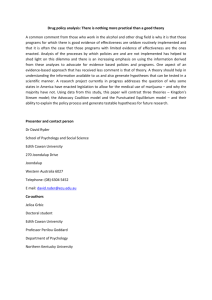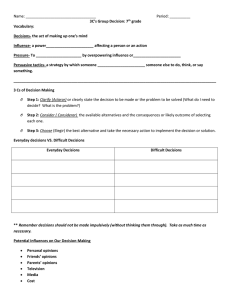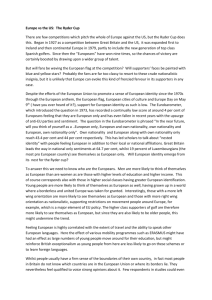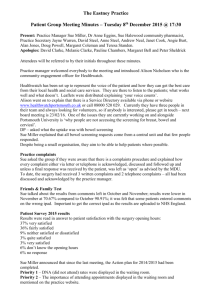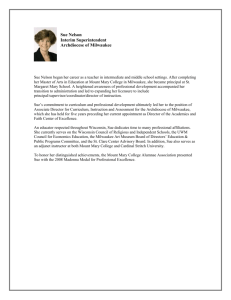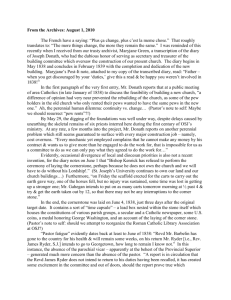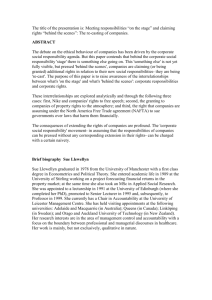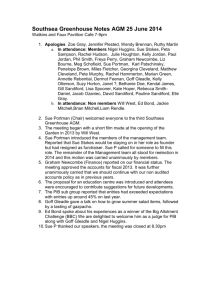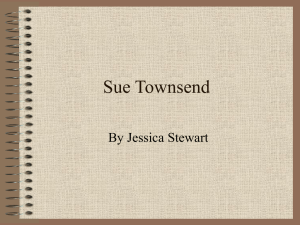Living through life’s challenges Quality Account 2009/10 Quality performance, initiatives and priorities
advertisement
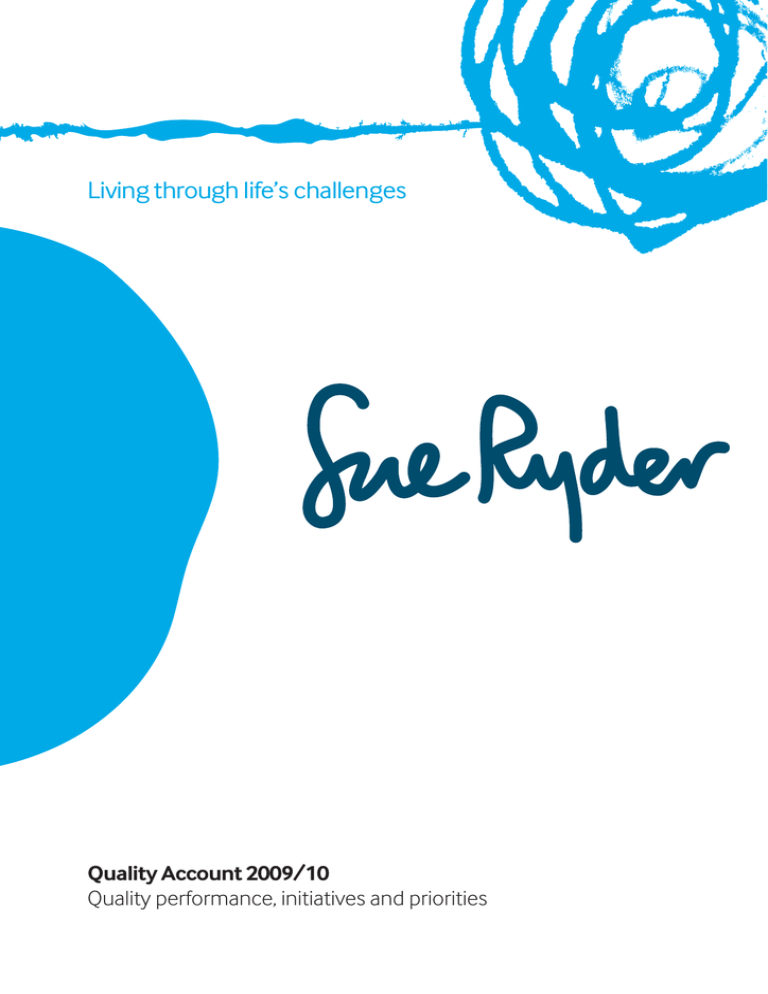
Living through life’s challenges Quality Account 2009/10 Quality performance, initiatives and priorities Who we are and what we do Sue Ryder provides compassionate health and social care for people living with life-threatening and longterm conditions. We are a national charity that delivers services to local communities through day care, respite care, homecare, hospices and hospice at home, longterm residential care, sheltered housing and community integration. Sue Ryder Quality Account lays out our continued priority to quality. Contents Who we are and what we do Statement by Paul Woodward, Sue Ryder Chief Executive Part 1: Our priorities for quality Part 2: Our priorities for improvement – Our four priorities – Priority 1: Service user experience – Priority 2: Effectiveness, safety and service user experience – Priority 3: Service user safety – reporting – Priority 4: Service user safety – falls Part 3: Our indicators – 1. Service user experience – 2. Safety – 3. Effectiveness Part 4: Annexes – Annex 1: Legal requirement – Annex 2: Statement from commissioning Primary Care Trust (PCT), OCS and LiN 2 Sue Ryder – Quality Account 2009/10 2 3 4 5 5 6 8 10 11 12 12 12 13 14 14 15 Quality issues – a continued priority Statement by Sue Ryder Chief Executive Welcome to our first annual Quality Account, a summary of our performance against selected quality measures for 2009/10 and our initiatives and priorities for 2010/11. In addition to embedding new quality initiatives throughout the organisation we also seek to embed a culture of Clinical Quality Improvement within each of our services. Each service has their own Quality Improvement Plan that reflects both local and national priorities, identifying quality improvement initiatives that enhance the safety, experience and outcomes for all our service users. We will continue to work closely with our staff to make addressing quality issues a continued priority. I am very pleased to have the opportunity to publish this Quality Account and to confirm my personal commitment to it. Paul Woodward Chief Executive, Sue Ryder Sue Ryder – Quality Account 2009/10 3 Part 1 Our priorities for quality Position and status on quality Sue Ryder is a national health and social care charity which provides specialist palliative care, neurological and homecare to people living with conditions such as cancer, dementia, Parkinson’s disease, Huntington’s disease and other complex conditions. The past year 2009/10 has been a positive year for the Sue Ryder Health and Social Care directorate in which we have made significant improvements in the quality of our services and key quality measures. The primary purpose of this quality account is to inform our service users, their families, our staff, supporters, the public and our Council of Trustees about the progress towards our annual key targets. To the best of my knowledge the information held within this quality account is accurate Paul Woodward Chief Executive, Sue Ryder 4 Sue Ryder – Quality Account 2009/10 Part 2 Our priorities for improvement Throughout 2009/10 we also identified and developed our priorities for the year 2010/11. In selecting our priorities we have been mindful of national and local policy as well as those issues which are of concern to our service users, our workforce, our partners and our Trustees. In setting our priorities we have attempted to set stretching and challenging targets which will make a real difference to the people who use our services. Our quality strategy focuses on three key areas: • Effectiveness • Service user safety • Service user experience Our four priorities Following our assessment the top priorities for 2009/10 will be: Priority 1: To achieve an overall service user experience rating of good or excellent on the service user survey Priority 2: To improve our quality rating at inspections Priority 3: To introduce an electronic incident reporting system Priority 4: To reduce the harm from falls These priorities have been approved by the Executive Management Team and our Board of Trustees. In selecting the priorities for 2010/11 we have consulted our Service User Advisory Group to ensure we focus on issues which are high priority for the people who use our services. Sue Ryder – Quality Account 2009/10 5 Priority 1 Service user experience To achieve an overall service user experience rating as 'good' or 'excellent' on the service user survey. We aim to provide the best possible experience for our service users by providing high quality and responsive services that closely meet people’s needs and preferences. We strive to provide services which are caring, supportive and in which people can have confidence. Feedback from our service users is crucial in order that we focus on what matters to people and we seek feedback through a number of different routes. However, to measure progress we will use the overall experience rating in our national service user survey. This is a composite measure and is therefore a good general measure of service user experience. A key part of current NHS and social care reforms are that people are given more choice and a much stronger voice. These requirements are reflected in our strategy for involving people in our care that aims to deliver: Measuring progress We will measure our success by how well service users rate us on key aspects of our care: • Percentage of service users who rate the care as good or excellent – standard measure of service user experience • Percentage of service users who overall feel treated with dignity and respect – key measure of service user experience • Percentage of service users who would recommend our service to friends or relatives – more demanding measure than just satisfaction • Total number of formal complaints The table below demonstrates how our service users rated our services in the service user survey, this data has been collected over 2009/10. • an organisational culture that values the views of service users and remains consistently receptive to their views • high quality services tailored to what service users say that they need • the development of services through proactive involvement of service users who represent the diverse range of people in our care • a practical structure that encourages and enables the involvement of service users at all levels of the organisation Indicator Neurological Care Palliative Care Homecare 86% 87% 99% 100% 86% 97% 91% 100% Data available 2010/11 10 80% 10 80% Data available 2010/11 Data available 2010/11 80% 70% Data available 2010/11 Service user experience Service users who rated overall care as good or excellent Service users who felt that overall they were treated with respect and dignity Service users who would recommend the service to family and friends Number of formal complaints % of formal complaints acknowledged within target of 2 days % of formal complaints responded to in writing within target of 20 days 6 Sue Ryder – Quality Account 2009/10 New initiatives in 2009/10 • We are providing new information about our services that helps service users make informed choices about their future care. The charity is accredited under the Department of Health Information Standard (IS). The first year has seen the development of core information about Homecare, Specialist Palliative Care and Neurological Care Centres. • We have established a new Service User Advisory Group, representing the diverse range of our service users throughout England and Scotland, to advise the Board of Trustees and ensure focus on service users. • We are improving how we use feedback to help shape our services. In 2009 a new service user survey programme was introduced. The views gathered from this and other sources of service user feedback are being regularly collated so we know what is most important to service users, where we are doing well, and areas for improvement. New initiatives for 2010-11 These include, improving how we manage complaints, by recording and learning from issues and trends raised through complaints. Also, working with the Service User Advisory Group to promote the importance of every person being treated as an individual, and what this means for people using our service. Executive Management Team sponsor Steve Jenkin, Director of Health and Social Care Implementation Lead Pam McClinton, Head of Clinical Quality and Risk Programme Manager Sarah Mudd, Service User Involvement Lead • We have a Service User Involvement Policy in place and a Strategy for people in our care to be involved in all aspects of our service delivery, evaluation and ongoing improvements. • We have reviewed our Complaints procedure and have updated our policy. We are starting to deliver training to all our staff on this new procedure. Sue Ryder – Quality Account 2009/10 7 Priority 2 Effectiveness, safety and service user experience To improve our quality ratings at inspections. Sue Ryder services are inspected by two regulatory bodies: • Care Quality Commission (England) • Care Commission (Scotland) Guidance on Compliance. During 2009 Sue Ryder adapted its quality monitoring processes in order to be ready for this change. The different services are currently inspected against a set of National Minimum Standards (England) and Care Standards (Scotland) and these standards vary dependent on the service and its registration. From October 2010 the Health and Social Care Services in England will be inspected against the new We aim to improve our inspection ratings to be rated good or above. The following table demonstrates an improvement or maintenance of inspection rating. In the majority of cases it offers a summary of CQC quality ratings for our services after 2 years. Hospices have not been included within this table as they are not graded. Date of inspection Service Current rating (at March 2010) Previous rating Direction of travel since last inspection Holme Hall Cuerden Stagenhoe The Chantry Hickleton Good – 2 stars Good – 2 stars Excellent – 3 stars Excellent – 3 stars Good – 2 stars Good – 2 stars (Aug 07) Adequate – 1 star (Sept 08) Excellent – 3 stars (April 07) Excellent – 3 stars (June 07) Good – 2 stars (Aug 06) Standards maintained Improvement Standards maintained Standards maintained Standards maintained Dee View Excellent/Very Good Excellent/Very Good (June 09) Standards maintained Excellent – 3 stars (annual service review) Excellent (Dec 07) Standards maintained Good (Dec 07) Excellent (Dec 08) Standards maintained Standards maintained Adequate (Dec 08) Good (Nov 08) Improvement Standards maintained Good (July 06) Rating has gone down. Inspected 29/3/2010 – awaiting report Standards maintained. Inspected on 11/4/10 – awaiting report Standards maintained Adult care – England August 2009 November 2009 March 2010 June 2009 August 2007 Adult care – Scotland January 2010 Care of older people – England Feburary 2010 Birchley Domiciliary Care – England December 2009 March 2010 Wigan (St Helen’s) Lincoln January 2010 January 2010 Macclesfield Wolverhampton July 2009 Leek (Staffordshire) Good – 2 stars Excellent – 3 stars (annual service review) Good – 2 stars Good – 2 stars (annual service review) Adequate – 1 star April 2009 Sale (Trafford) Adequate – 1 star Adequate (April 08) February 2009 Doncaster (Mexborough) Bixley Rd Ipswich (Independent Living) Good – 2 stars Good – 2 stars (March 07) Good – 2 stars August 08 was the first inspection NA Primarily Good and Adequate Primarily adequate (March 09) Improvement August 2008 Domiciliary Care – Scotland Feburary 2010 8 Arbroath Sue Ryder – Quality Account 2009/10 The six Sue Ryder Hospices are inspected by the Care Quality Commission and do not receive an overall rating. Four of these Hospices have received an inspection during the 2009/2010 year. The two other Hospices received an inspection towards the end of the 2008/2009 year. All four Hospices inspected during this year met the majority of standards based on either their self assessment or the standards that were assessed on the day. Where standards were not met or were partially met, the service then put together an action plan to address any requirements and recommendations. These were progressed through monitoring at quarterly quality visits by a member of the Clinical Quality Team. Examples of two areas identified for improvements have related to the update of Human Resource Policies and Procedures and the implementation of a Risk Register. Sue Ryder has learnt from this, and a new Written Controls Process has been introduced. A plan to introduce risk registers at corporate level and at service level was already identified within the Risk Strategy and this is now being implemented across all services influenced by a corporate Health and Social Care Risk Register. Sue Ryder – Quality Account 2009/10 New initiatives for 2010 These have included: • Further review of the quality visit process for Hospices and Neurological Care Centres based on regulatory requirements • Introduction of a revised quality visit process within Domiciliary Care Services • Continued quarterly reporting of inspection findings to the Healthcare Governance Committee and Integrated Governance Committee, with actions taken in response to inspection and organisational learning • Increased operational support to Care Managers in Homecare to support quality improvement initiatives Executive Management Team sponsor Steve Jenkin, Director of Health and Social Care Implementation Lead Pam McClinton, Head of Clinical Quality and Risk 9 Priority 3 Service user safety – reporting To introduce an electronic incident reporting system The way in which an organisation manages risk is a key indicator of its competence. Managing risk, the identification and effective treatment of risk, and learning from adverse events protects those who receive care, staff and assets, improves performance and reputation, and helps to reduce financial loss. Sue Ryder set out its proposal to introduce a more reliable system of monitoring incidents in its Risk Management Strategy for 2008-2011. The purpose of this strategy was to further develop an integrated approach to risk management across Healthcare. The strategic objectives were organised under the headings in the NPSA Seven Steps to Patient Safety (2004) and the introduction of a web based electronic incident reporting tool was a key objective within the ‘promoting reporting’ step. The Charity agreed to promote reporting of incidents using new technology with the aim of providing management information at all levels. It purchased an electronic risk management tool (Datix) that is compatible with the current Sue Ryder computer system and that meets the requirements of health and safety reporting and data collection, service user safety reporting and the monitoring of complaints. During 2009 a designated project group (including representatives from the Health and Safety Team, Clinical Quality Team and IS&T Services): 1. Set out a detailed project plan for implementation and use of the tool across all Health and Social Care Services by March 2010 2. Configured the tool to meet the requirements of the Charity (Datix has primarily been used within the NHS) 3. Piloted the tool within three sites representing all Health and Social Care Services 4. Reviewed the tool based on feedback from the pilot 5. Designed training materials to support use of the tool 6. Revised the Incident and Near Miss Policy in line with procedural change 10 Sue Ryder – Quality Account 2009/10 Between January 2010 and April 2010 the project group: 1. Arranged and delivered training to front line staff and managers 2. Arranged ‘go live’ dates for each service 3. Developed a reporting process to the Healthcare Governance Committee New initiatives for 2010 1. To further refine the tool based on feedback from services and learning from the process of producing reports 2. To use the latest version of Datix which has greater functionality but does not change the process of reporting for front line staff 3. Build a portfolio of reports to inform the Head of Operations and Head of Clinical Governance and Quality 4. Inform further development of the Health and Social Care Risk Register 5. Use of the Complaints Module within Datix with the aim of improving the monitoring and learning from complaints Executive Management Team sponsor Steve Jenkin, Director of Health and Social Care Implementation Lead Pam McClinton, Head of Clinical Quality and Risk Programme Manager Helen Press, Quality and Risk Manager Priority 4 Service user safety – falls To reduce the harm from falls New initiatives for 2010 Falls are known to be the most reported safety incident reported nationally, many of which result in harm to the person who is receiving care. There will always be a risk of falls within health and social care services given the nature of the people we care for. However, there is much that can be done to reduce the risk of falls and to minimise harm, whilst at the same time enabling service users to be independent and as mobile as possible. 1. Completion of a Falls Prevention Leaflet (for people in receipt of care and their families) 2. In conjunction with the introduction of electronic incident reporting, closer monitoring of the number of falls and the factors associated with falls 3. Falls risk management training incorporated into induction and annual priority training 4. Audit of compliance with policy across services During 2009 the Clinical Quality Team in conjunction with the Health and Safety Team launched a major initiative to reduce the risk of falls with the aim of reducing harm from falls. The reason for this was based on the fact that incident figures indicated that the risk of falls was and is a key area of risk within the Charity. Whilst many falls do no result in harm to the person receiving care, in some cases injury occurs with the potential for serious injury resulting in distress to the person receiving care and possible admission to hospital. Executive Management Team sponsor Steve Jenkin, Director of Health and Social Care Implementation Lead Pam McClinton, Head of Clinical Quality and Risk Programme Manager Helen Press, Quality and Risk Manager The prime aim of the project was to manage this risk from falls as far as possible without impeding a service user’s right to independence and choice. A small project group was formed and had representation from Health and Social Care Services in addition to a member of the Clinical Quality Team and Health and Safety Team. Achieved during 2009: 1. Development of a Falls Risk Management Policy and Procedure (incorporating strategies to reduce the risk of falls) 2. Development of a ‘falls toolkit’ incorporating: • a validated falls risk assessment • falls risk assessment guidelines • decision making tool (with regard to the use of bed rails) • prompt for care planning • guidance for detailed falls incident reporting • environmental assessment tool 3. Revision of the bed rails risk assessment tool and guidelines 4. Provision of a training pack to support implementation of the policy Sue Ryder – Quality Account 2009/10 11 Part 3 Our indicators Indicator Neurological Care Palliative Care Homecare Service users who rated overall care as good or excellent Service users who felt that overall they were treated with respect and dignity Service users who would recommend the service to family and friends Number of formal complaints % of formal complaints acknowledged within target of 2 days % of formal complaints responded to in writing within target of 20 days 86% 87% 99% 100% 86% 97% 91% 100% Data available 2010/11 10 80% 10 80% Data available 2010/11 Data available 2010/11 80% 70% Data available 2010/11 Indicator Neurological Palliative Homecare 1. Service user experience 2. Safety Regulatory body inspection rating (Neurological and Homecare only) Percentage of care standards met or exceeded by those Hospices inspected1 Number of incidents resulting in serious injury per year Number of medicines administration incidents per year Number of medicines prescription incidents per year Number of slips trips and falls resulting in serious injury per year Number of reports under RIDDOR Environment score and percentage compliance with standards2 Number of Healthcare Acquired Infections and pressure ulcers acquired within our own service or acquired externally See section on Priority 2 above for details 92% (3 services) 4 43 1 10 2 53 17 1 Data available 2010/11 Data available 2010/11 Data available 2010/11 Data available 2010/11 14 243 (82%) 1 264 (89%) Data available 2010/11 See section below 1. Four Hospices were inspected during 2009/2010. The percentage in the table is based on the results of inspection for three Hospices as the final report is awaited for a Hospice Inspection that took place December 2009. The percentage calculation is based on an assumption that standards that were not inspected were found to have been met within the annual self assessment. 2. The environment score is a composite indicator which measures compliance with a number of safety standards within the care centres and hospices. Audits are undertaken on the communal areas and service users’ own rooms to ensure that a safe and clean environment is maintained. There are two key risk areas that have been identified within Sue Ryder services and these are medicines management and falls. In response to the incidents relating to falls Sue Ryder has introduced a new Falls Risk Management Policy and toolkit (refer to Priority 4). As a result of this new policy and the accompanying training a falls risk assessment is completed at admission and is repeated if a service user falls so that new risk management measures can be considered and incorporated into the care plan. 12 Sue Ryder – Quality Account 2009/10 Following a medicines incident a ‘drug risk matrix’ is used to promote a fair approach to the management of staff who are involved in an incident. Retraining and competency assessment is often used in response and the Medicines Management Policy has been reviewed at least annually based on the learning from incidents or to action national safety alerts that relate to medicines management. 3. Effectiveness HCAI and pressure ulcers The number of infections and pressure ulcers across all neurological and palliative centres reflects the period between July 2009 and March 2010. Cases are identified as those which were acquired by the service user whilst under the care of Sue Ryder and those acquired prior to the service user being admitted to a Sue Ryder service. Neurological Neurological Health Care Acquired Infections (HCAI) Acquired in Sue Ryder Clostridium Difficile Norovirus MRSA infection MRSA colonised Hepatitis (A, B or C) Influenza Pressure Ulcers Pressure ulcers 1 Palliative Acquired External to Sue Ryder Acquired in Sue Ryder 1 23 13 Total Acquired External to Sue Ryder 6 1 2 4 2 1 21 30 40 119 Acquired External to Sue Ryder 6 1 2 27 13 1 140 70 ● Acquired within own service ● Acquired external to service Number of HCAI (July 2009 – March 2010) 30 Number of new cases Acquired in Sue Ryder 25 20 15 10 5 0 Clostridium Difficile Novirus Number of pressure ulcers (July 2009 – March 2010) Number of new cases 140 MRSA Infection MRSA Colonised Hepatitis (A, B or C) Influenza ● Acquired within own service ● Acquired external to service 120 100 80 60 40 20 0 Neurological Centres Sue Ryder – Quality Account 2009/10 Palliative Care 13 Part 4 Annexes Annex 1 There is a legal requirement to report on this section: • During the period of this report, 1 April 09 to 31 March 2010 Sue Ryder provided NHS-funded community health services through its 6 Adult Hospices, 5 Day Hospices, 1 Hospice at Home service, 2 Community Nursing Services and 6 Care Homes with Nursing . • The percentage of NHS funding is variable depending on the nature of the service ranges from 35 per cent to 90 per cent of the total cost of providing the service. The shortfall is met from Sue Ryder charitable income. • Sue Ryder has reviewed all the data available to it on the quality of care in all of the services detailed in the preceding section • The income generated by the NHS services reviewed in the period 1 April 2009 to 31 March 2010 represents 100 per cent of the total income generated from the provision of NHS services by Sue Ryder for the period 1 April 2009 to 31 March 2010. • During the period from 1 April 2009 to 31 March 2010 there were no national clinical audits covering the NHS services that Sue Ryder provides. • Clinical audits have taken place within Sue Ryder; these form part of the annual audit calendar programme implemented for services July 09 – March 10. The monitoring, reporting and actions following these audits ensure care delivery is safe and effective. The clinical audit calendar included Documentation, Medicines Management, Falls Prevention, pressure Ulcer assessment and Management, Documentation, Care at death Audits, environmental and hand hygiene audit. • Key learning apart from the results of the audits themselves included the fitness for purpose of the tools used and the way in which this data can be captured. • Where indicated changes are implemented at an individual, team or service level and further monitoring is used to confirm improvement in healthcare delivery. • During that period from 1 April 2009 to 31 March 2010 Sue Ryder was not eligible to participate in national clinical audits. • The number of patients receiving NHS services provided or sub-contracted by Sue Ryder from 1 April 2009-March 2010 that were recruited during that period to participate in research approved by a research ethics committee was nine. 14 Sue Ryder – Quality Account 2009/10 • Sue Ryder income in this reporting period was not conditional on achieving quality improvement and innovation goals through the Commissioning for Quality and Innovation payment framework because these schemes had not yet been implemented by local commissioners. • Sue Ryder is required to re-register with the Care Quality Commission by 30 September 2010. Until re-registration Sue Ryder will not know if it has any conditions on its registration. • The Care Quality Commission has not taken enforcement action against Sue Ryder during the period 1 April 09 to 31 March 2010. • Sue Ryder is not re-registered with the Care Quality Commission. It will not know until 1 October 2010 whether it will be subject to periodic reviews by the Care Quality Commission and, if so, what form these will take. • Sue Ryder has not participated in any special reviews or investigations by the CQC during the reporting period. • Sue Ryder did not submit records during the period from 1 April 2009 to 31 March 2010 to the Secondary Uses service for inclusion in the Hospital Episode Statistics which are included in the latest published data. • Sue Ryder was not eligible to be scored for the period 1 April 2009 to 31 March 2010 for Information Quality and Records Management, assessed using the Information Governance Toolkit. • Sue Ryder was not subject to the Payment by Results clinical coding audit during the period 1 April 2009 to 31 March 2010 by the Audit Commission. Annex 2 Statement from commissioning PCT, OSC and LiN’s NHS Leeds was approached for comment on the national Sue Ryder Quality Account 2009/10, following guidance from the Department of Health that advice should be sought from the organisation’s largest value NHS commissioner. We approached NHS Leeds which commissions services from one of our hospices. NHS Leeds notes the areas we have identified for improvement during 2010/11. These are: Priority 1: To achieve an overall service user experience rating of good or excellent on the service user survey Priority 2: To improve our quality rating at inspections Prioirty 3: To introduce an electronic incident reporting system Priority 4: To reduce the harm from falls As outlined in this document, associated progress measures and related new initiatives make a significant contribution to the delivery of safe, high quality services which reduce health inequalities and improve outcomes for service users and carers. NHS Leeds commends Sue Ryder for the publication of its Quality Account 2009/10 at a time that community providers do not have to publish until 2010/11. These comments are qualified by an inability to endorse the accuracy of the information presented. Sue Ryder – Quality Account 2009/10 15 Sue Ryder 114 –118 Southampton Row London WC1B 5AA Sue Ryder Care is a charity registered in England and Wales (1052076) and in Scotland (SC039578). Ref No.0329.p/B/P/H © Sue Ryder Care. June 2010.
